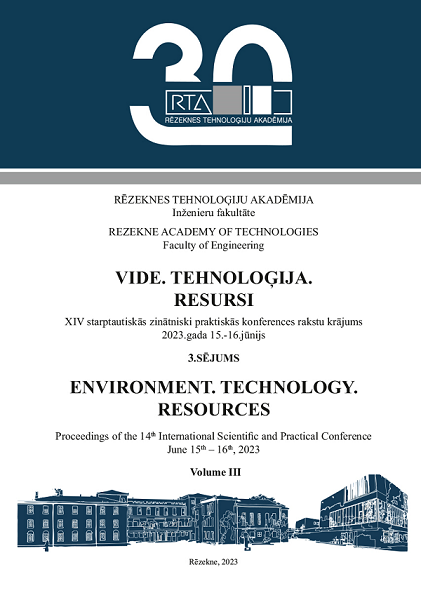SOLVING FUNCTIONAL-TECHNOLOGICAL PROBLEMS USING A NON-PARAMETRIC APPROACH FOR CONTROL OF MICROGEOMETRY OF THE SURFACES OF DETAILS
DOI:
https://doi.org/10.17770/etr2023vol3.7230Keywords:
surface roughness, non-parametric method, graphic images, theory of experimental planningAbstract
In the article considers the effect of surface roughness on the functioning of a specific mechanism. In case of proven dependence of the studied functional property of surface microgeometry, a process of optimization of the sought parameter is carried out, in which the methods of mathematical analysis and theoretic foundations of technology of appliance and mechanical engineering are used for the basis of the theoretical studies. As control parameters of the specified optimal microgeometry, deciding the given task, the so-called non-parametric criteria are used, namely graphical of certain surface-profile functions.
References
V.M. Musalimov, V.A. Valetov. Dynamics of frictional interactions: Monograph: in 2 parts. - St. Petersburg: PIMash Publishing House (State St. Petersburg Institute of Mechanical Engineering LMZ-VTUZ)), 2006., p. 191 (in Russian).
H. Metev, K. Krumov, A. Lengerov. Determination of inoccoracies in the reporting by turning the phenomenon of heredity technology. Journal of the Technical University - Sofia, Plovdiv branch, Bulgaria « International Scientific Conference on Engineering, Technologies and Systems TECHSYS 2018». –Р. 227–232.
V.A. Valetov. Additive technologies (state and prospects). Tutorial. - St. Petersburg: ITMO University, 2015, p.63.
Chirag Patel, Mangal Bhatt. Investigation of Phy-sical Characteristics and Machining Parameters of Impro-ved Al-SiC MMC Using Dry EDM Process for Aerospace Industries. JoEAM. 2018. P. 15–32.
A.Y. Ivanov, D.B. Leonov. Methodology for optimization, evaluation and control of products surface roughness // Journal of the Technical University - Sofia, Plovdiv branch, Bulgaria «Fundamental Sciences and Applications». – 2012, Volume 17, pp. 19–23 (in Russian).
E. Filimonova. Automation of the control of microgeometry of machine parts and devices’ surfaces using topography, IX All-Russian Mechanic University Conference of Young Scientists. 5th session of the scientific school "Problems of mechanics and accuracy in instrumentation". - St. Petersburg, 2012. - Issue. 1. - pp. 132 - 136. - 152 (in Russian).
V.A. Valetov. Feasibility of changing the standard for surface roughness of parts. Intercollegiate collection No. 6. St. Petersburg, Northwestern State Polytechnic University, 1997, pp. 118-121 (in Russian).
I.N. Gibadullin, V.A. Valetov. Image of the surface profile as a graphic criterion of its roughness. Journal of Instrument Engineering. 2019. Vol. 62, N 1. P. 86—92 (in Russian).
V.A. Valetov, I.N. Gibadullin. Surface roughness of parts and quality of functional properties of products //Journal of Metalworking, Politechnika Publishing House, 2017. V. 101, No. 5. pp. 38-43.
I.N. Gibadullin, V.A. Valetov. Automated control of the microgeometry of surfaces of parts using graphic images of profiles. Journal of Instrument Engineering (Izvestiya vysshikh uchebnykh zavedeniy. Priborostroenie), 2017. V. 60, No. 3. pp. 287-289.
V.A. Valetov. Problems of optimization of workpiece surface microgeometry to ensure specific functional properties. Journal of Instrument Engineering, 2015, vol. 58, no. 4, pp. 250–267 (in Russian).
D.B. Leonov. Technological methods for controlling the roughness of the product surfaces // Collection of scientific papers from the 2012 scientific session at Vasil Levski National University, Part 1., Shumen, 2012, pp. 77–81 (in Bilgarian).
V.A. Valetov, E.A. Filimonova, Program for automated control of surface microgeometries using non-parametric criteria, Metalworking, No. 5, 2011, pp. 44-47 (in Russian).
V.A. Valetov, E.A. Filimonova, Automation of surface microgeometry control using non-parametric criteria, Materials of the 14th International Scientific and Practical Conference, Saint Petersburg, 2012 (in Russian).
E.A. Filimonova. Development of Methodology and Software for Automated Control of Instruments Surface Microgeometry using Graphical Criteria and their Application in Technological Research. Eng. Sci. Dis. Thesis. St. Petersburg, 2014, 24 p (in Russian).
A.Y. Ivanov, D.B. Leonov. Assessment of the influence of surface roughness on the corrosion resistance of machine-made products // Scientific and technical journal of information technologies, mechanics and optics. – 2013, Issue 6(88), pp. 144–147 (in Russian).
D.B. Leonov, I.L. Lilov. Metodology for optimizing the influence of surface roughness of the functional properties of details in mechanical engineering // Machines, Technologies, Materials. – 2015. - Issue 5. – Р. 46–47.
Guidelines 109-77. Methodology of selection and optimization of controllable parameters of technological processes. Intr.01.07.1978, M, Standards Publishing House, 1978, 48 p (in Russian).
Yu.S. Andreev, N.A Demkovich, R.M. Isaev, A.A. Tselishchev, S.D. Vasilkov. Determination of the microgeometry of the functional surface of a part that provides the required performance of an aviation vibration sensor // Scientific and technical bulletin of information technologies, mechanics and optics. 2016. V. 16. No. 6. pp. 1103–1110. D.
V.V. Maksarov, R.V. Vyushin, A.E. Efimov. Technological support of surface layer roughness based on transient modeling // Journal of Metalworking, Politechnika Publishing House, 2017. No. 2 (98). pp. 39–46.
S.D. Tretyakov, O.S. Yulmetova. On the problems of optimizing the microgeometry of the surface layer of instrument parts. Journal of Instrument Engineering (Izvestiya vysshikh uchebnykh zavedeniy. Priborostroenie), 2010. V. 53, No. 8. pp. 12-15.
Yu.S. Andreev, V.V. Medunetsky. Research of surface microrelief changes during their sliding friction. Journal of Instrument Engineering (Izvestiya vysshikh uchebnykh zavedeniy. Priborostroenie), 2012. V. 55, No. 9. pp. 30-34.
V.A. Krasny, V.V. Maksarov. Tribotechnical characteristics of mining machine parts with regular surface microgeometry, Journal of Metalworking, Politechnika Publishing House, 2016. No. 1 (91). pp. 29–36.
O.S. Yulmetova, M.S. Tutova, R.F. Yulmetova. Chemical analysis of thin-film’s colour generation during surface laser oxidation of TiN-coating. Journal of Physics: Conference Series. 2018. Vol. 1124. No. 8. pp. 081010. [Тип: Статья, Год: 2018]
T.O. Tolstykh, L.A. Gamidullaeva, E.V. Shkarupeta. Key factors in the development of industrial enterprises in the conditions of industry 4.0 // Russian journal of industrial economics, 2018. V. 11, No. 1. pp. 11-19.



